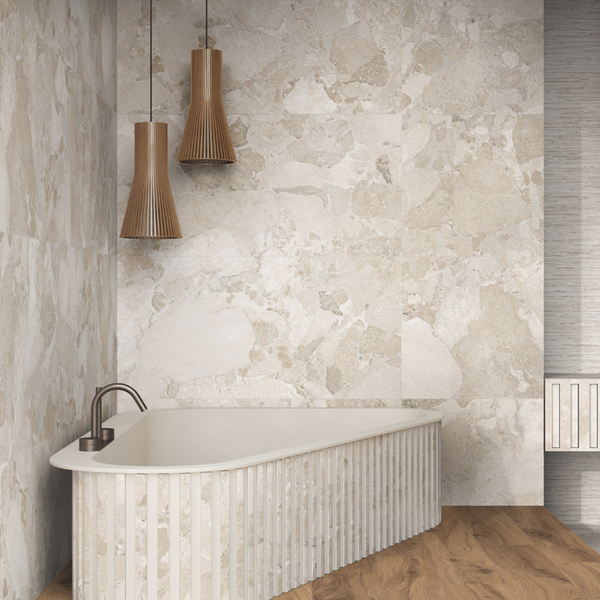Bathroom Panels vs Tiles: Costs, Installation, Pros & Cons
Jul 21, 2025
When renovating a bathroom, you have a choice – do you install tiles, or do you go for an alternative?
Tiles are always the better choice in terms of durability. They’re the strongest and most resilient material for bathroom walls and floors. But you’ll usually need to employ a specialist to install tiles in a bathroom to ensure they’re sealed and laid evenly.
Not everyone enjoys the look of tiles in a home, and there are alternatives to tiles. Bathroom panels are a popular choice. They aren’t as strong, but they are cheaper and easier to install with little DIY knowledge.
Keep reading for a quick, easy comparison of using bathroom panels instead of tiles (with pros, cons, and costs), plus a guide to the most popular bathroom tile alternatives.
Using Bathroom Panels vs Tiles: Which is Best?
As a quick, direct comparison, here’s when it might be best to use wall panels instead of tiles in a bathroom, and vice versa:
- Wall panels: Better if you’re on a tight budget and/or want to renovate a bathroom yourself. It’s also a good option if you only need the panels to last a couple of years or you’re not worried about adding extra value to your property.
- Bathroom tiles: Better if you want a long-term solution that lasts a lifetime. It’s a great option for family homes, as it’s hard to damage tiles during daily use or when cleaning the bathroom. Tiles also add value to a property more than wall panels do.
4 Popular Bathroom Tile Alternatives: Comparing Pros, Cons, Costs & Installation
The most popular tile alternatives are wall panels, natural stone cladding, luxury vinyl, or simply adding a splash of fresh paint on the walls. Here’s a quick guide to bathroom tile alternatives to help you choose.
1. Bathroom Panels (PVC, Fiberglass, or Acrylic)
You can get three different types of bathroom panels (as an alternative to tiles), which include PVC wall panels, fiberglass panels, and acrylic panels.
Types of bathroom panels (instead of tiles):
- PVC: As the most popular bathroom panel, it’s the cheapest and easiest to install. The surface is water-resistant and easy to clean, but it isn’t very durable. It won’t last long and, since it’s made from plastic, it can release harmful chemicals over time.
- Acrylic: These panels are cheap, waterproof, and exceptionally lightweight, making them easy to install. The downside is that they can scratch easily and yellow over time. You also need to avoid using abrasive cleaners, as these will cause irreversible damage.
- Fiberglass: It’s cheap and lightweight, but it isn’t strong and it cracks or chips under heavy pressure. The colouring can fade over time and the surface scratches easily if you use harsh cleaners or scrub hard.
Pros & Cons of Bathroom Panels
- Pros of bathroom panels: They can be cheaper than tiles and can easily be installed by yourself with little DIY knowledge. They also offer a clean look, as you don’t have any grout lines.
- Cons of bathroom panels: They don’t last very long, and they can chip, scratch, or even crack under heavy impact. After a while, they can also fade in colour or start to yellow.
Costs & Installation of Bathroom Panels
- Costs: Depending on the material, you can usually install bathroom panels for a price of around $150 to $250 per panel (compared to $50 to $150 per square meter for tiles).
- Installation: Usually cheap, quick, easy, and suitable for DIY-ers.
2. Natural Stone Cladding (Marble or Granite)
Another tile alternative is natural stone “bathroom panels”, which are not quite the same as bathroom panels, but they look similar. They offer a sleeker look compared to PVC panels, plus they last a lot longer and have a more value-adding effect on your property.
- Pros of natural stone: Lasts a long time, and has a luxurious, high-end appearance, with the potential to add value to your property.
- Cons of natural stone: More expensive compared to other options and requires specialist installation to secure the panels sufficiently.
Shop our collection of natural stone tiles for your bathroom today.
3. Painted Walls
You can simply paint the walls in a bathroom instead of tiling, which is a very cheap and DIY-friendly way to spruce up a bathroom.
However, paint can start to flake under high humidity, even if you use special bathroom paint. If water splashes on the walls, it can also cause damp, which can spread throughout the home and cause mold.
- Pros of painted walls: It’s great if you’re on a budget and if you’re only applying paint to certain walls of a bathroom (e.g., above a basin splash back or away from the shower/bathtub).
- Cons of painted walls: The paint can flake if humidity isn’t managed and you shouldn’t have painted walls in a shower, as it can cause damp-related structural problems and leaks throughout the home.
4. Luxury Vinyl
You can install luxury vinyl on the walls or floors of a bathroom instead of tiles. These come in luxury vinyl planks (LVP) and luxury vinyl tiles (LVT).
Luxury vinyl planks look like laminate or hardwood, but they’re made from waterproof PVC. Naturally, LVT looks like porcelain or ceramic tiles.
- Pros of luxury vinyl: It’s easy to cut and install (perfect for DIY-ers), highly water-resistant and long-lasting, with a similarly beautiful texture underfoot as real hardwood or stone tiles.
- Cons of luxury vinyl: While it’s scratch-resistant and waterproof, it’s important that vinyl is installed properly to ensure it’s completely sealed and protected against moisture damage.
Another alternative to wood in a bathroom is wood-look tiles, which can be added to walls and floors in a bathroom to create a rustic feature. Shop wood-look bathroom tiles today.
FAQs
Are Tiles Better Than Bathroom Panels?
It depends on what you like, but when you compare the two, tiles are the better choice. They last longer and they’re very hard to crack or scratch.
When installed properly, tiles are completely waterproof and protect the bathroom entirely from any adverse effects of damp and humidity. If you spill lotions, you’ll probably never stain tiles (unless you have natural stone tiles, which are softer and require a little extra care).
You can use any cleaner on porcelain or ceramic tiles without causing damage, which you can’t do with bathroom panels.
Tiles also look pretty and natural in a bathroom, and they can even add value to a property. Homeowners view tiles as a sign of a well-maintained, long-lasting bathroom, which can make the home more desirable.
Can I Have a Bathroom Without Tiles?
You don’t have to use tiles in a bathroom, but most people do because they’re strong, versatile, and easy to care for. If you don’t want tiles in your bathroom, you can install something different, like wall panels.
Find Your Style – Shop Tiles Today
Tiles in a bathroom aren’t for everyone, but they certainly have their benefits.
If you love the durability and style of installing tiles in your home, shop our bathroom tiles in Australia today.
At Stone and Tile Projects, we supply a gorgeous collection of bathroom tiles in Sydney, including ceramic, porcelain, and natural stone tiles.



